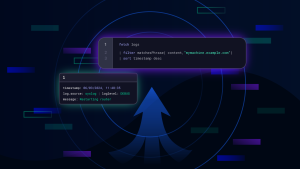Distributed cloud systems are difficult to manage without the proper tools. Learn how comprehensive log management helps improve security, operational efficiency, and uptime.
What is log management?
Log management is the practice of continuously gathering, storing, processing, and analyzing data from various programs or applications. In log management, logs are leveraged to optimize system performance, identify technical issues, manage resources efficiently, enhance security, and improve compliance. Most infrastructure and applications generate logs that need log management. In cloud-native environments, there can also be dozens of additional services and functions all generating data from user-driven events.
A log is a computer-generated file that captures activities within the operating system or software applications. Log management involves activities such as log collection, aggregation, parsing, storage, analysis, search, archiving, and disposal.
Key components of log management include:
- Collection: Aggregating data from different sources, Dynatrace collects logs through One Agent or APIs or Open Telemetry
- Observability: Tracking events and activities across logs, metrics, users’ sessions, and distributed traces
- Analytics: Reviewing logs, metrics, and traces to identify bugs or security threats
- Retention: Designating how long log data should be kept
- Search: Filtering and searching data across all logs
- Reporting: Automating reporting for operational performance, security, and compliance
Metrics, logs, and traces make up three vital prongs of modern observability. This is critical to ensure high performance, security, and a positive user experience for cloud-native applications and services. Event logging and software tracing help application developers and operations teams understand what’s happening throughout their application flow and system which is another key component of log management. Together with metrics, three sources of data help IT pros identify the presence and causes of performance problems, user experience issues, and potential security threats.
Log management tools help organizations manage the high volume of log data generated across the enterprise by determining what data needs to be logged, for how long it should be saved, and how data should be disposed of when no longer needed.
Dynatrace log management involves aggregating all log data into Dynatrace Grail data lakehouse to provide visibility into workloads, applications, multiple environments, forgotten assets for optimizing cloud spending, and improving compliance posture. Log management is crucial for compliance requirements such as FISMA, HIPAA, SOX, GLBA, PCI DSS, and GDPR. Log management tools are essential for monitoring system performance, enhancing security measures, troubleshooting issues effectively, optimizing resource usage, improving compliance posture, and providing real-time insights into operations.
While logging is the act of recording logs, organizations extract actionable insights from these logs with log monitoring, log analytics, and log management.
Why is a log management tool important?
Distributed cloud systems are complex, dynamic, and difficult to manage without the proper tools. Log management is a key factor in successfully deploying and operating large-scale cloud applications or resources, as cloud-native systems are often more difficult to observe than on-premises solutions. With comprehensive logging support, security, operational efficiency, and application uptime all improve.
Two major benefits of properly managed logs are their availability and searchability. Optimally stored logs enable DevOps, SecOps, and other IT teams to access them easily. This enables IT teams to quickly and efficiently find the answers they need. Essentially, log management tools help with organizing logs to ensure log searches and queries are as efficient as possible.
How log management systems optimize performance and security
Logs are among the most effective ways to gain comprehensive visibility into your network, operating systems, and applications.
Logs provide detailed information about the data that traverses a network and which parts of applications are running the most. This helps organizations identify application performance bottlenecks. Developers can use logs, for example, to identify areas of code that are executed more frequently than needed or run for longer durations than expected. Teams can also parse logs to show the application owner which actions users are taking most often.
When it comes to security, logs can capture attack indicators, such as anomalous network traffic or unusual application activity outside of expected times. In many cases, attackers erase their activities from some logs. Audit logs that record high-value and potentially problematic operations — such as the transfer of data outside the organization — need to be instantly stored and protected from tampering.
Log management challenges and how to face them
Log management faces two primary challenges in cloud environments: scope and variability. First, midsize and large organizations now generate and collect terabytes of data per day from thousands of events, and this trend shows no signs of slowing down. As a result, logging tools record large event volumes in real time. Scalable storage is a hallmark of cloud applications, but real-time event recording, tracking, and indexing requires specialized tools, especially for large-scale deployments with petabytes of data.
As logs are generated, log variability creates another challenge for modern DevOps and SecOps professionals. Logs are not a one-size-fits-all file, but they must suit the specific tool or metric on which they report. For instance, a user login log will generate a format that’s different from a cloud resource utilization alert. Log management tools are purpose-built to aid in generating and organizing the proper types of logs for each situation. The ideal solution automatically keeps these different types of logs in proper context with other data and dependencies.
Log management best practices for improved performance
Other than the obvious organization, searchability, and real-time monitoring use cases, log management tools provide ways to further use these records to improve organization-wide performance. For instance, powerful log breakdown and search features enable IT pros to use logs to find other logs. If IT teams identify a concerning event, but can’t find the root cause by looking at the incident log, log management dashboards can show other logs connected to that event or service. What else did the initial event affect? How did those secondary events affect performance or security?
Similarly, a comprehensive logging and management platform provides mechanisms to create custom recording and alerting. As a result, IT teams can detect event patterns. The platform targets specific resources to provide increased visibility in areas of concern.
The keys to a good log management system are flexibility, customizability, and depth of observability.
Comparing log monitoring, log analytics, and log management
Many people often confuse log monitoring, log analytics, and log management with one another, but each activity brings a unique capability to the table. Log monitoring is the process of continuously observing log additions and changes, tracking log gathering, and managing the ways in which logs are recorded.
Log analytics, on the other hand, is the process of using the gathered logs to extract business or operational insight. These two processes feed into one another. Log monitoring enables the collection of log data, and log analysis promotes intelligent, data-driven decision making.
Log management brings together log monitoring and log analysis. It is common to refer to these together as log management and analytics. It involves both the collection and storage of logs, as well as aggregation, analysis, and even the long-term storage and destruction of log data. In short, log management is how DevOps professionals and other concerned parties interact with and manage the entire log lifecycle.
Automatic and intelligent log detection
Log management is critical to understanding system performance, user issues, and application security vulnerabilities. But log data can create another data silo for IT pros to manage and manually correlate with other data.
Observability is a multifaceted issue and can be split into three components: metrics, traces, and logs. For context, teams collect metrics for further analysis and indexing. They include user data, resource usage, application performance, and more. Traces are the observable ways in which cloud services interact with one another. User verification, payment validation, and other microservices may interact with each other in ways that are difficult to track without ecosystem-wide observability support.
Logging solutions such as Dynatrace provide automated, intelligent tools for log gathering, ingestion, and dependency mapping that allow DevOps, SecOps, and other professionals to have full observational power over complex cloud ecosystems.
The Dynatrace platform ingests logs, metrics, and traces. But it also provides a real-time dependency mapping of all applications, services, and other resources. Combined with the contextualized, real-time software intelligence of Davis, the platform provides precise answers for IT teams that need to identify issues proactively and at enterprise scale.
For more information on the use of logs and how Dynatrace increases observability, check out our power demo.





Looking for answers?
Start a new discussion or ask for help in our Q&A forum.
Go to forum